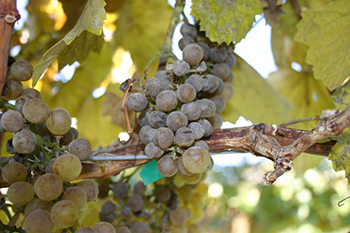Whether they are grown for wine, raisins or the table, grapes are one of the most important crops in the U.S., with a value of more than $5 billion. But they are threatened by a fast-adapting fungus that is developing resistance to common, effective control products, leaving growers vulnerable to crop loss.
To keep grapes affordable and environmentally sustainable, mechanical engineering associate professor Rob Stoll and partnering institutions are launching a four-year, $4.75 million project aimed to reduce fungal resistance to low-cost, pest-specific controls, ensuring we can keep enjoying grapes and wine.
Race against disease
Cracking grape berries and covering leaves in white, powdery mildew is the bane of grape growers nearly every year, costing millions nationally to manage and driving up the cost of production.
For years, U.S. grape growers have relied on inexpensive, effective treatments to protect their crop from the disease. But powdery mildew is developing resistance to common controls, putting the future of sustainable grape production in jeopardy.
Funded by the U.S. Department of Agriculture’s Specialty Crop Research Initiative and led by researchers at Washington State University and the USDA Agricultural Research Service, the project, FRAME: Fungicide Resistance Assessment, Mitigation and Extension Network for Wine, Table and Raisin Grapes, will improve how we detect and predict resistance, and develop strategies that help growers, educators and manufacturers reduce the economic impact of resistance.
Preserving the best defense

Growers and scientists around the world have seen the steady emergence of mildew populations that resist targeted, inexpensive chemicals. Without them, growers are forced to use harsher, broad-spectrum treatments more often, or risk losing their crop entirely.
By understanding how mildew develops resistance and how that mildew spreads, researchers will help the grape industry balance economical, environmentally-friendly practices with their disease management goals.
Developing a network of experts and a community of knowledge, molecular biologists on the team will create better, faster tests for resistance, while Extension specialists set up service centers across the U.S. to put those tests into practice.
FRAME engineers will model resistance hotspots using local weather and topography, while viticulturists and field pathologists will test management strategies in the vineyard. At the same time, economists will research ways to encourage farmers and distributors to use spray practices that prevent resistance.
For a full list of team members and details about the grant, visit the NIFA grant website.